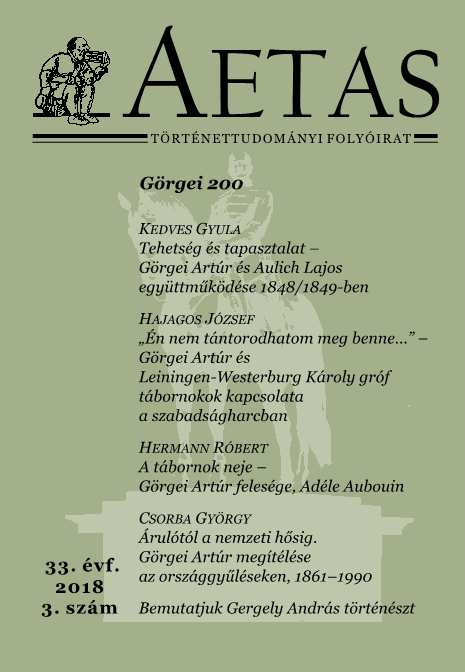A tábornok neje. Görgei Artúr felesége, Adèle Aubouin
The general’s spouse –Artúr Görgei’s wife, Adéle Aubouin
Author(s): Róbert HermannSubject(s): 19th Century
Published by: AETAS Könyv- és Lapkiadó Egyesület
Summary/Abstract: Present study summarizes the life of Artúr Görgei’s wife, the Alsace-born Adéle Aubouin, based partially on the memoires of Mrs. Görgei, and partially on the family correspondences kept in the Hungarian public archives. The first chapter discusses the youth of the orphan Adéle Aubouin up to her marriage to Artúr Görgei. The two young people might have first met in 1845-1846. Görgei proposed to the woman who worked as a governess at that time in January 1848, they got married in March in Prague, then returned to the estate of Görgei’s aunt in Toporc. At the end of May Görgei went to Pest and joined the army. The second chapter looks at the period of Mrs. Görgei life between May 1848 and August 1849, when the young woman lived the life of an average army wife. They spent most of the War of Independence apart from each other. At the end of August 1849, when it became clear that Franz Joseph I will pardon Görgei, they set out together to his designated place of residence, Klagenfurt, Carinthia. After 1849 Görgei had little room for activity. Between 1849 and 1867 he lived under police surveillance in Klagenfurt, Carinthia, then in Viktring with his wife and two children Berta (1850-1934) and Kornél (1855-1933), who were born there. The third chapter examines this period. During these eighteen years his wife kept the family together, she was the one to help her husband get over his regular periods of despair and guilt. After the Austro-Hungarian Compromise the wife facilitated the homecoming of Görgei as well, she even visited Ferenc Deák and Count Gyula Andrássy, the Prime Minister of Hungary. The Hungarian circles accepted the spirited woman. Furthermore, the son of Görgei’s former “hostess” at Világos, Antónia Szőgyén, the wife of János Bohus, got engaged to, then married their daughter, Berta Görgey. This year is the topic of the fourth chapter. However, the long exile and the excruciating return home eroded the couple’s relationship. Görgei came home in December 1867, and his wife in February 1868, but they lived separately for the most part. When their daughter’s marriage ended Görgei blamed his wife for this, among others. The fifth chapter discusses this. After 1875 we have no information about their relationship for about 20 years, but they had more or less regular correspondence from January 1893 until Adéle’s death. Görei even offered to move in together again. However, he did so on the condition that she stops supporting their son, Kornél financially. Mrs. Görgei died on 21 July 1900 in Lőcse, and she was buried in the graveyard of Toporc, in the parcel of the Görgey family. The sixth chapter discusses this period. The final chapter summarizes the complicated story of Mrs. Görgei’s memoires. At the end of her life she dictated her memoires to her son, Kornél, who sold the manuscript after his mother’s death, but the general’s brother, István Görgey managed to buy it back. He gave it to his nephew, Albert Görgey, who later lent the manuscript to Samu Kardos, a lawyer and amateur historiographer from Debrecen. Even though he put it down in writing that he won’t publish any parts of the manuscript without the permission of István and Albert, in 1911 he published a summarized translation of the work in the newspaper Az Est (The Evening) in 16 parts. The original manuscript has been lost since then, but due to this publication, the majority of the text is available to us.
Journal: AETAS - Történettudományi folyóirat
- Issue Year: 2018
- Issue No: 3
- Page Range: 69-101
- Page Count: 33
- Language: Hungarian

